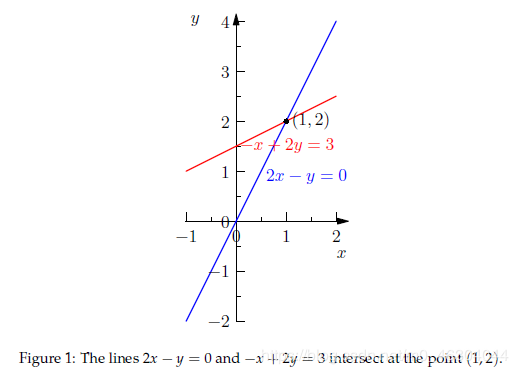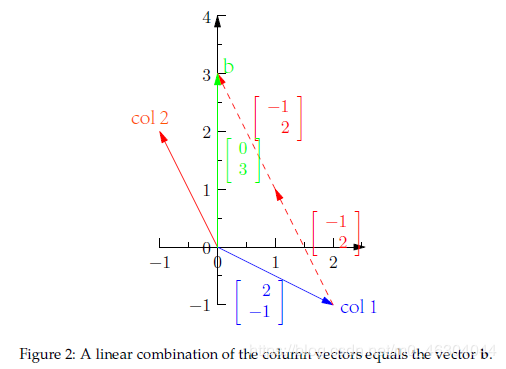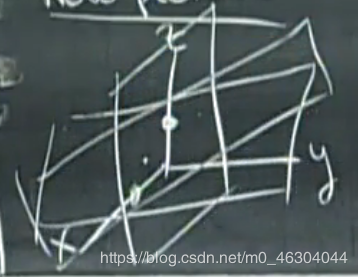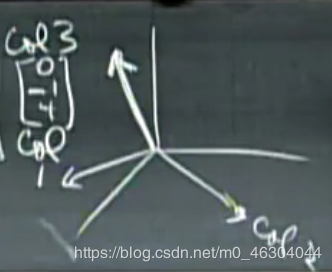MIT线性代数Linear Algebra公开课笔记 第一章 线性方程的几何表示(lecture 1 The geometry of linear equations)
本章是Gilbert Strang的MIT线性代数公开课中【第一章 线性方程的几何表示(lecture 1 The geometry of linear equations)】的笔记,参考他在 MIT Linear Algebra课程网站上公开分享的 lecture summary (PDF) & Lecture video transcript (PDF)等文档,整理笔记如下,笔记中的大部分内容是从 MIT Linear Algebra课程网站上的资料中直接粘贴过来的,本人只是将该课程视频中讲述的内容整理为文字形式,后面的章节会按照视频顺序不断更新~
The fundamental problem of linear algebra, which is to solve a system of linear equations(线性方程组)。从nnn个方程,nnn 个未知数个数讲起,In this first lecture on linear algebra we view this problem in three ways.
1) Row picture:the picture of one equation at a time (矩阵的行)
2)Column picture (矩阵的列)
3)Matrix form
For example: 二维
2x−y=0−x+2y=32x-y=0 \\ -x+2y=32x−y=0−x+2y=3
1)Matrix form:
[2−1−12][xy]=[03]\left[
\begin{matrix}
2& -1\\
-1& 2
\end{matrix}
\right ]
\left[
\begin{matrix}
x\\
y\\
\end{matrix}
\right ]
=\left[
\begin{matrix}
0\\
3
\end{matrix}
\right ][2−1−12][xy]=[03]
系数矩阵:A=[2−1−12]A= \left[ \begin{matrix} 2& -1\\ -1& 2 \end{matrix} \right ]A=[2−1−12],
未知数矢量:X=[xy]X=\left[\begin{matrix} x \\ y \end{matrix}\right ]X=[xy] ,b=[03]b=\left[\begin{matrix} 0 \\ 3 \end{matrix} \right ]b=[03] , 则线性方程组为AX=bAX=bAX=b.
2) Row picture:
一次取一行,作图与xy平面,Plot the points that satisfy each equation,即分别为满足2x−y=02x-y=02x−y=0和−x+2y=3-x+2y=3−x+2y=3的直线。The intersection of the plots (if they do intersect) represents the solution to the system of equations. Looking at Figure 1 we see that the solution to this system of equations is x=1,y=2x = 1, y = 2x=1,y=2.

3)Column Picture
将两个方程放到一起考虑
x[2−1]+y[−12]=[03]x\left[
\begin{matrix}
2\\
-1
\end{matrix}
\right]+
y\left[
\begin{matrix}
-1\\
2\\
\end{matrix}
\right]
=\left[
\begin{matrix}
0\\
3
\end{matrix}
\right ]x[2−1]+y[−12]=[03]
即寻找正确的线性组合 (Linear combinations of columns)
将列向量画出来,再进行线性组合(x和y的所有线性组合可以构成整个平面)
For example: 三维
2x−y=0−x+2y−z=−1−3y+4z=4
2x-y=0\\
-x+2y-z=-1\\
-3y+4z=42x−y=0−x+2y−z=−1−3y+4z=4
1)Matrix form:
A=[2−10−12−10−34],b=[0−14]A= \left[ \begin{matrix} 2&-1&0\\ -1&2&-1\\ 0&-3&4 \end{matrix} \right ],b=\left[\begin{matrix} 0\\ -1\\ 4\end{matrix}\right ]A=⎣⎡2−10−12−30−14⎦⎤,b=⎣⎡0−14⎦⎤
2) Row picture:
每个方程确定一个平面,两个平面交于一条直线,三个平面相交于一个点,这个点就是解。

3)Column Picture
x[2−10]+y[−12−3]+z[0−14]=[0−14]
x\left[
\begin{matrix}
2\\
-1\\
0
\end{matrix}
\right ]
+
y
\left[
\begin{matrix}
-1\\
2 \\
-3
\end{matrix}
\right ]
+
z
\left[
\begin{matrix}
0\\
-1\\
4
\end{matrix}
\right ]=
\left[
\begin{matrix}
0\\
-1\\
4
\end{matrix}
\right]x⎣⎡2−10⎦⎤+y⎣⎡−12−3⎦⎤+z⎣⎡0−14⎦⎤=⎣⎡0−14⎦⎤
解为:x=0,y=0,z=1x=0,y=0,z=1x=0,y=0,z=1

4)big picture:保持左侧矩阵不变,然后考虑不同的右侧向量
x[2−10]+y[−12−3]+z[0−14]=[11−3]x
\left[
\begin{matrix}
2\\
-1\\
0
\end{matrix}
\right ]
+
y
\left[
\begin{matrix}
-1\\
2 \\
-3
\end{matrix}
\right ]
+
z
\left[
\begin{matrix}
0\\
-1\\
4
\end{matrix}
\right ]=
\left[
\begin{matrix}
1\\
1\\
-3
\end{matrix}
\right ]
x⎣⎡2−10⎦⎤+y⎣⎡−12−3⎦⎤+z⎣⎡0−14⎦⎤=⎣⎡11−3⎦⎤
解为:x=1,y=1,z=0x=1,y=1,z=0x=1,y=1,z=0
若考虑所有的右侧向量,是否每一个方程都可以求解?
此问题等价于代数问题:对于任意bbb,是否能求解Ax=bAx=bAx=b? (Can I solve Ax=bAx=bAx=b for every bbb? )
等价于线性组合说法:Do the linear combinations of the columns fill three dimensional space? , Every b means all the bs in three dimensional space.)
For this matrix A – for these columns, the answer is yes. This matrix is a non-singular matrix 、an invertible matrix. There could be other matrices where the answer becomes no.(如果三个列向量同处一个平面(例如列1+列2=列3),即A为奇异矩阵(非可逆矩阵),它的列向量线性相关,那么其组合肯定也在该平面上,所得到的b也必然处于这个平面以内,因此当b处于这个平面内时有解,但大部分不在平面内的b是无法构造的,即无解.
假设向量有9个分量,假设9方程、9未知数,则一共9列,每一列都是九维空间的向量,然后考虑其线性组合,则得到了九维空间中的9个向量的线性组合,是否可以总是得到b?(注:若用MATLAB取random矩阵,一定是非奇异可逆的)。若九个向量均线性独立,则可以覆盖整个九维空间,但如果恰巧第九列等于第八列,则只能覆盖九维空间中的某八维空间,最后的求解也只能在这个八维平面上展开。
Matrix Multiplication方程组的矩阵形式, Ax=bAx=bAx=b
How do we multiply a matrix AAA by a vector xxx?
[2513][12]=?\left[
\begin{matrix}
2& 5\\
1& 3
\end{matrix}
\right ]
\left[
\begin{matrix}
1\\
2\\
\end{matrix}
\right ]
=?
[2153][12]=?
Method 1: the entries of x as the coefficients of a linear combination of the column vectors of the matrix:
[2513][12]=1[21]+2[53]=[127]
\left[
\begin{matrix}
2& 5\\
1& 3
\end{matrix}
\right ]
\left[
\begin{matrix}
1\\
2\\
\end{matrix}
\right ]
=1
\left[
\begin{matrix}
2\\
1\\
\end{matrix}
\right ]
+2
\left[
\begin{matrix}
5\\
3\\
\end{matrix}
\right ]=
\left[
\begin{matrix}
12\\
7\\
\end{matrix}
\right ]
[2153][12]=1[21]+2[53]=[127]
This technique shows that Ax is a linear combination of the columns of A.
Method 2: taking the dot product(点乘即内积) of each row of A with the vector x:
[2513][12]=[2⋅1+5⋅21⋅1+3⋅2]=[127]
\left[
\begin{matrix}
2& 5\\
1& 3
\end{matrix}
\right ]
\left[
\begin{matrix}
1\\
2\\
\end{matrix}
\right ]=
\left[
\begin{matrix}
2·1+5·2\\
1·1+3·2
\end{matrix}
\right ]=
\left[
\begin{matrix}
12\\
7\\
\end{matrix}
\right ]
[2153][12]=[2⋅1+5⋅21⋅1+3⋅2]=[127]
reference: lecture summary (PDF) & Lecture video transcript (PDF)
作者:WongRUIRui